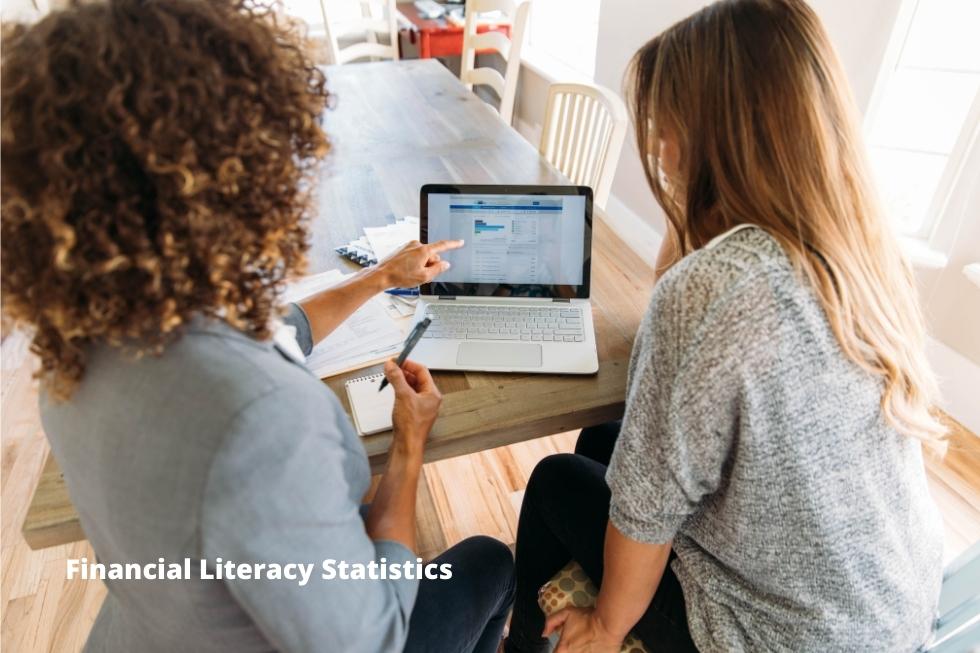
Financial crises and financial literacy have been the subject of a great deal of research.
The study discovered that being more literate in financial topics is linked to a person’s ability to overcome macroeconomic adversity, such as COVID-19 or the 2008 economic collapse.
Money is a significant concern for many Americans, and the problem persists worldwide. Overdraft charges are on the rise while income remains level.
Personal financial skills are harmed if individuals do not have a broad understanding of financial knowledge at the community level, and — on a national scale — the economy suffers. Fortunately, many Americans are becoming financially literate and seeking to understand the fundamentals to make better financial decisions.
The existing financial knowledge of basic financial ideas and the generational, demographic, and geographical differences in the distribution of money knowledge are addressed.
Table of Contents
Key Facts About Financial Literacy Statistics
- Only one-third of people worldwide have a basic grasp of financial ideas.
- According to a recent survey, more than half of all adults in the United States have less-than-desirable money management skills. Financial illiteracy affects 7 out of every 10 Americans.
- More than half of millennials are only beginning to learn about financial concepts. Only 24% of Millennials understand fundamental financial topics.
- States that require high school students to take a personal finance course in 2020 will increase by 24 % from the year before.
- Americans have low household and retirement savings and high levels of credit card and student loan debt due to a lack of Financial Literacy Statistics.
- High schools in 23 states must now teach financial literacy, which will rise to 24 states by 2022. In addition, 25 states demand that high school students take an economics course.
- Investopedia’s readers showed a keen interest in credit- and debt-related themes in the states where people are experiencing the most financial difficulty.
Financial Literacy Statistics as an Average
A solid financial literacy statistics knowledge promotes fiduciary trust and improves money management skills, decision-making capability, and sound budgeting and spending habits.
However, the problem with standardized financial literacy programs is that they must be tailored to each client’s unique situation. “When you boil it all down, you have to start where the person is and let them dictate how fast they can move forward,” says Joyce Serido, an associate professor and extension specialist at the University of Minnesota.
- According to the poll, money is a major stressor for 65 % of all adults. More so (73 %) for people with a household income of under $50,000.
- According to surveys, people are the least informed about subjects concerning financial risk.
- According to a survey conducted by the American Institute for Economic Research, among those ages 18 and over who are employed and have bank accounts, 15.2 % of people would not be able to pay their monthly bills if they incurred an unexpected expense of $400 or more (11.8 % of men vs. 22.6 % of women).
- Spending more than one’s income was reported by 24% of respondents.
- People who are active participants in a friendly community and those who invest in the stock market have a good relationship.
- Those who had state-mandated personal finance classes in high school were less likely to borrow high-interest loans than those who didn’t have to take the courses.
- High financial literacy scores are associated with a 70 % chance of learning about money through personal experience.
- According to a recent survey, nearly two-thirds (63 %) of Americans don’t have $1,000 set aside for an emergency.
Financial Knowledge Across Generations
People’s lives experience affects their capacity to learn about money, which results in various levels of knowledge throughout periods and necessitates personalized financial training based on one’s life condition. To stay up with the ever-changing economy, continuous learning is required during one’s life cycle.
“A process that should start at a young age and continue throughout one’s life is Financial Literacy Statistics,” according to economist and former Chair of the Federal Reserve Alan Greenspan. “The development of these skills enables people to make critical financial choices about assets…and improve their economic well-being.”
- Married millennial women are more likely than married Gen X and married Baby Boomer women to be financially secure.
- According to a survey by Bankrate, only a quarter of millennials can comprehend fundamental financial concepts.
- Although Gen X is more likely to retire than Millennials, they have about the same amount of money saved.
- Older people overconfident in their financial knowledge tend to engage in riskier financial activity.
- Over 60% of parents said they’d provided their children with financial assistance in the previous year.
- 75 % of Millennials are afraid of “falling out of control,” with 54 % believing that the phrase implies they will be completely broke.
Minority Groups and Financial Literacy Statistics Rates
Despite similar economic contributions, there is a vast financial disparity between minority and non-minority groups. Financial literacy statistics reveal knowledge gaps according to the home origin, median household income, and level of education, among other factors.
- Compared to Caucasians, minorities have a 9 to 16 % lower financial literacy.
- Women are less likely than males to receive Financial Literacy Statistics.
- According to the 2019 Financial Literacy Scorecard, African Americans have a lower financial literacy level (41 %) than the national average (48 %).
- Incarcerated females have the highest rates of poverty compared to incarcerated males and the male and female general public.
- Immigrants’ test scores for financial literacy fall by about 27 % due to their immigration status.
- People with disabilities are less likely to respond appropriately to financial literacy measures, regardless of their age or background.
Financial Literacy Statistics in America
As Sehgal sees it, the bigger picture is that a better world economy begins on Wall Street. “I believe the money for global solutions is on Wall Street. Capital allocation is something we do on Wall Street. And we need to get capital to the successful ideas, whether through microfinance or financial literacy programs, and Wall Street can be the engine that drives capital to those in need.”
Proper Financial Literacy Statistics increase the potential for economic success. As more data becomes accessible, governments and educational institutions have begun to use a standardized, more efficient method of teaching the general public.
- 4 in 7 Americans are financially illiterate, and more than half of them state that they cannot handle their finances.
- States that required high school students to take a personal finance course in 2020 rose by 24% from 2018.
- Americans spent $1,600 each in 2020 and $415 billion on poor financial literacy.
- Only 34 % of Americans can answer at least four out of five basic financial literacy questions.
- Virginia, Utah, and New Hampshire are the most financially literate states, whereas Mississippi, Alaska, and Louisiana are the least financially informed.
- In 2019, 70% of high school students in the United States chose to take a personal finance course. However, just 17% were required to do so.
International Financial Literacy Statistics
Financial literacy fosters a prosperous international economy and informs governments about how to create effective initiatives. In many countries, the absence of Financial Literacy Statistics is a barrier to participating in an international economy. Many world citizens are excluded from gaining basic financial services due to a lack of information, which leads to their being shunned from progressing their financial knowledge.
- Denmark, Germany, the Netherlands, and Sweden are among the most financially literate nations in the EU (65% of adults have a high school diploma or equivalent.)
- According to the World Bank, only 6 % of individuals in the smallest economies reported having enough financial cushion to last a week if faced with adversity.
- In Australia, nearly 50% of people (8.5 million) are financially illiterate.
- Only one-third of the world’s population is aware of fundamental financial topics.
- Canadian citizens’ financial well-being score is 66 out of 100, with less than a fifth indicating they were in debt.
- Only 25 % of the population in South Asia is literate, which is the lowest financial literacy rate among all regions.
Statistics Show Millennials Worried About Financial Illiteracy
- According to Bank of America, only 16% of Americans between the ages of 18 and 26 are “quite” or “extremely” optimistic about their financial situation.
- Only about a quarter (24%) of millennials were confident in their ability to pay off student loans if they had them, according to PwC.
- According to the National Financial Educators Council, 5.2 % of respondents were turned down for a job because of their lack of financial knowledge, and 18.2% said they weren’t sure (National Financial Educators Council).
- The top 10 states had an average of 71.7 %. In contrast, the bottom ten just over half (50/100) (Past research has shown that adults with a high level of financial literacy are more likely to have saved enough for a down payment on a home and can make better financial decisions). Individuals in North Dakota, which ranked fourth out of all 50 states on a Financial Literacy Statistics examination, had the greatest %age of respondents, 55.5%, who declared they had an emergency fund (US Financial Capability).
- Vermont, which came second out of all 50 states on a financial literacy test, had the lowest proportion of non-bank borrowing methods (15.2%), according to the US Financial Capability site.
Conclusion
It is predicted that financial literacy rates will continue to rise in the next five years. This means that more and more people will be making informed decisions about their money and future. Financial institutions, educators, and individuals all have a role in ensuring this happens. Are you ready for the challenge?
Additional Financial Literacy Resources
The greatest potential for a healthy financial future for yourself and future generations is to integrate personal financial literacy statistics into current government and institution initiatives. The first step in gaining adequate knowledge is recognizing the resources available for further education.
Statistics for this article were gathered from the following sources:

Petri Maatta is a photographer, filmmaker, and webdesigner who has been working for over 20 years in the creative industry. Fascinated by manifesting for business reasons, Petri was determined to find out what it took to create success. He started his career with seven years of business failures before he found success by learning about manifesting from a mentor with a Fortune 500 company. Today Petri shares his knowledge through DreamMaker courses designed to help people change their businesses and lives while living on their terms.
STAY IN THE LOOP
Subscribe to our free newsletter.
Stay up to date! Get all the latest & greatest posts delivered straight to your inbox


